Shifting Sands: The Global Impact of Opium Production’s Move from Afghanistan to Myanmar
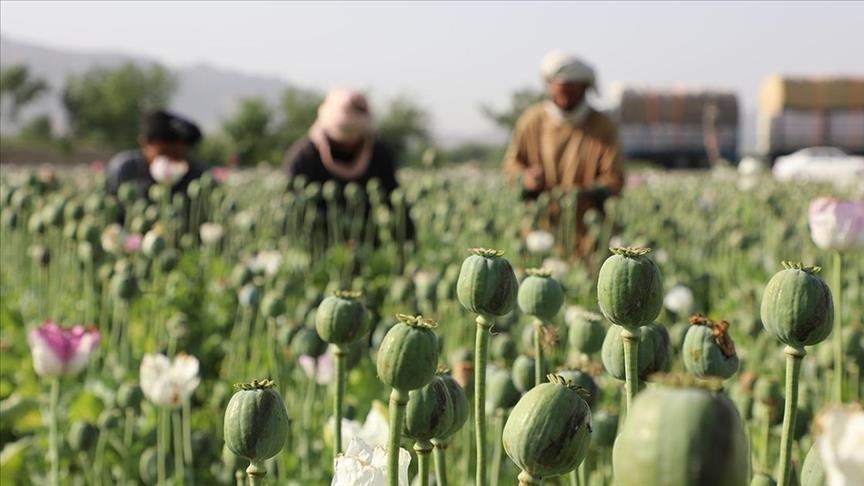
![]()
Sarder Ali Haider[1]
For over two decades, Afghanistan has stood at the epicenter of global opium production, a distinction that has significantly influenced both its domestic affairs and international relations. Nestled within its tumultuous political and social landscape, opium cultivation flourished, propelled by a combination of economic desperation, regional instability, and the absence of viable agricultural alternatives. This cultivation became the backbone of rural economies across vast swathes of the country, providing critical livelihoods for countless Afghan families.
Afghanistan’s dominance in the opium market did not go unnoticed. The country’s vast poppy fields supplied the majority of the world’s heroin, fueling a global health crisis that transcended borders and cultures. The implications of this trade were far-reaching, affecting global narcotics policy, law enforcement strategies, and international diplomatic relations. Efforts to curb the cultivation faced numerous challenges, including the complex dynamics of local governance, the ever-changing political landscape, and the sheer scale of the operation.
The situation took a dramatic turn with the Taliban’s return to power. Known for their previous, albeit short-lived, crackdown on opium production in the late 1990s, the Taliban once again declared a ban on opium cultivation. This policy shift promised to redraw the contours of global opium production and trade, with potential implications for both Afghanistan’s economy and the international narcotics market.
As the world watched to see the impact of the Taliban’s ban, a significant shift was already underway. Opium production began to migrate to a new epicenter—Myanmar. This transition posed new challenges and questions for the region and the world at large. How would this shift affect global drug trafficking routes, regional stability, and the lives of those dependent on the opium trade for their survival?
This article explores the complexities of this transition, exploring the historical context of Afghanistan’s role as a leading opium producer, the implications of the Taliban’s ban, and the emergence of Myanmar as the new hub of opium cultivation. Through this exploration, we aim to shed light on the multifaceted impacts of this significant shift in the landscape of global opium production.
Historical Context of Opium Production in Afghanistan
Afghanistan’s journey to becoming the world’s leading opium producer is rooted in its complex historical, socio-economic, and geopolitical landscape. For centuries, the rugged terrains of Afghanistan have hosted the cultivation of poppies, the raw material for opium and its derivatives, including heroin. However, it was during the latter half of the 20th century that the country’s opium production began to escalate dramatically, influenced by a confluence of domestic and international factors.
The Soviet Invasion and Its Aftermath
The pivotal shift began in the late 1970s and early 1980s, following the Soviet invasion of Afghanistan. The ensuing conflict devastated the country’s traditional agricultural infrastructure, leaving the economy in ruins and the population in dire need of income. Opium poppy cultivation emerged as a lucrative alternative for many Afghan farmers, offering a source of revenue in an otherwise crippled economy. The chaos of war and the lack of a central governing authority provided a fertile ground for the opium trade to flourish.
Mujahideen and Warlord Era
Throughout the 1980s and 1990s, Afghanistan’s opium production continued to grow, fueled by the Mujahideen resistance against the Soviet occupation and later, the internal strife among warlords following the Soviet withdrawal. These groups often financed their military operations through opium trade, embedding the cultivation and trafficking of opium deeply into the fabric of Afghan society and its economy. The absence of effective law enforcement and governance allowed the opium economy to expand virtually unchecked.
The Taliban and Opium Production
The Taliban’s rise to power in the mid-1990s introduced a new chapter in Afghanistan’s opium saga. Initially, the Taliban permitted opium cultivation, capitalizing on the trade as a significant revenue source. However, in a surprising move in 2000, the Taliban imposed a strict ban on opium cultivation, leading to a dramatic but temporary reduction in production. This ban was short-lived, as the subsequent U.S. invasion in 2001 and the resulting instability enabled opium production to surge once again.
Post-2001 Surge in Production
The period following the ousting of the Taliban by U.S.-led forces saw a significant increase in opium production. Efforts by the international community and successive Afghan governments to curb opium cultivation faced numerous challenges, including corruption, lack of security, and the absence of alternative livelihoods for rural populations. As a result, Afghanistan solidified its position as the world’s largest opium producer, contributing to the global opiate supply and exacerbating addiction crises worldwide.
The history of opium production in Afghanistan is a testament to how geopolitical events, economic desperation, and the absence of stable governance can combine to influence global narcotics trade. The shift in production following the Taliban’s recent ban on opium cultivation marks the latest chapter in this complex history, with significant implications for Afghanistan and the new epicenter of opium production, Myanmar.
Economic, Social, and Political Factors Contributing to Opium Cultivation
Opium cultivation in Afghanistan, deeply embedded within the country’s socio-economic fabric, has been influenced by a confluence of factors. These elements, ranging from economic necessity to political instability, have collectively shaped the landscape of opium production, making it a critical yet controversial component of Afghanistan’s identity on the global stage. Understanding these factors provides insight into the challenges and complexities involved in addressing the opium trade.
Economic Factors
Lack of Alternatives: In Afghanistan’s rural areas, the absence of viable agricultural alternatives has made opium poppy cultivation an attractive option. Opium poppies are drought-resistant, require less water than many traditional crops, and are significantly more profitable. For many farmers living in poverty, opium cultivation is a lifeline, offering a higher income than other forms of agriculture.
Market Demand: Global demand for opiates, both for medicinal and illicit use, has sustained high prices for opium, making it an economically rational choice for Afghan farmers. The lucrative nature of the opium trade, compared to the low returns on conventional crops, has perpetuated its cultivation.
Infrastructure and Access: Afghanistan’s rugged terrain and lack of infrastructure limit access to markets for other agricultural products. In contrast, opium, being compact and high in value, can be transported and traded more easily, making it a practical economic activity in remote areas.
Social Factors
Rural Livelihoods: For many communities, opium cultivation is not just an economic activity but a social one, deeply integrated into the fabric of rural life. It provides employment not just for farmers but for laborers involved in the harvest and processing stages.
Tradition and Resistance: In some areas, opium cultivation has been practiced for generations, making it a traditional part of local agriculture. Additionally, during periods of foreign intervention or unpopular domestic governance, opium production has been viewed as a form of resistance or autonomy.
Dependency Cycle: Families and communities often find themselves trapped in a cycle of dependency on opium production. Initial engagement with the opium economy can lead to debt, particularly with drug traffickers or lenders, forcing continued cultivation as a means of repayment.
Political Factors
Conflict and Instability: The persistent conflict and political instability in Afghanistan have significantly contributed to the growth of opium production. Warlords, insurgent groups, and corrupt officials have exploited the opium trade to finance their activities, further entrenching its role in the economy.
Weak Governance: The inability of successive Afghan governments to enforce laws or provide alternatives has allowed opium cultivation to flourish. Efforts to curb production have often been undermined by corruption within the political system.
International Influence: Foreign intervention and aid strategies have sometimes had unintended consequences for opium production. Efforts to eradicate opium fields without providing sustainable alternatives have often led to resentment among local populations, sometimes driving them further into the opium trade.
The intersection of these economic, social, and political factors has made opium cultivation a resilient feature of Afghanistan’s landscape. Efforts to address the opium problem thus require a multifaceted approach, taking into account the deep-rooted causes and providing viable alternatives to those dependent on its cultivation for their livelihoods.
The International Impact of Afghanistan’s Opium Production
Afghanistan’s opium production has had profound and far-reaching impacts on the international stage, influencing global drug markets, public health, and security policies. As the world’s leading producer of opium, Afghanistan has been at the center of a complex web of issues that extend well beyond its borders.
Global Drug Markets: Afghanistan’s opium has supplied the bulk of the world’s heroin, significantly affecting the global drug trade. The availability of Afghan heroin in various regions has been linked to fluctuations in drug purity, price, and the rate of drug addiction. This dynamic has posed challenges for law enforcement and drug policy makers worldwide.
Public Health Crisis: The flow of heroin from Afghanistan has contributed to a global public health crisis, with increases in heroin use disorder, HIV/AIDS, and other drug-related harms. Countries along the trafficking routes, from Central Asia to Europe, have been particularly affected by health issues associated with intravenous drug use.
Financing Conflict: The revenues generated from opium production have financed not only the Taliban but also other insurgent groups and warlords in Afghanistan. This aspect has made opium a key factor in the country’s ongoing conflict and instability, complicating international peacekeeping and counter-insurgency efforts.
Policy and Diplomatic Relations: Afghanistan’s opium production has been a contentious issue in international relations, affecting the country’s diplomatic ties with neighbors and global powers. Efforts to curb production have involved a wide range of strategies, from military intervention to development aid, reflecting the complex interplay between narcotics control and foreign policy.
The Taliban’s Ban on Opium Production
Upon their return to power in 2021, the Taliban announced a ban on opium production, echoing a similar prohibition they briefly enforced in the late 1990s. This move was part of broader efforts to gain international legitimacy and address one of the most controversial aspects of their governance. The ban was communicated through decrees and enforced by Taliban officials, who warned of severe consequences for violators.
Immediate Effects on Local Farmers and the Economy
The ban on opium production had immediate and significant effects on local farmers and the Afghan economy:
Economic Hardship for Farmers: For many rural families, opium poppy cultivation was their primary source of income. The ban left them facing economic uncertainty and hardship, with few alternatives for livelihoods in a country already grappling with poverty and displacement.
Disruption of Local Economies: The opium trade was a key component of Afghanistan’s informal economy, involving not just farmers but also traders, laborers, and others in the supply chain. The ban disrupted local markets and economies, particularly in regions heavily dependent on opium revenue.
The Global Reaction to the Taliban’s Ban
The international community’s reaction to the Taliban’s ban on opium production was mixed:
Skepticism and Cautious Optimism: While some viewed the ban as a positive step towards addressing the global opium problem, others were skeptical of the Taliban’s commitment and capacity to enforce it effectively, given the economic dependence on opium in many rural areas.
Concerns for Humanitarian Impact: International organizations and governments expressed concern about the ban’s immediate impact on Afghan farmers and the wider population, stressing the need for support and alternative livelihood programs to mitigate economic hardship.
Impact on Global Drug Markets: The ban’s long-term effects on global heroin markets remain uncertain, with potential shifts in supply, trafficking routes, and drug prices. Some experts predict a temporary decrease in heroin availability, leading to increased prices and potentially a surge in synthetic drug alternatives.
The Taliban’s opium ban represents a significant policy shift with implications for Afghanistan and the world. Its success and sustainability depend on the Taliban’s ability to enforce the ban, the international community’s response, and the availability of alternative livelihoods for those affected.
Shift of Opium Cultivation to Myanmar
With the Taliban’s crackdown on opium production in Afghanistan, there has been a noticeable shift in opium cultivation to other regions, most prominently Myanmar. Myanmar, part of the Golden Triangle alongside Laos and Thailand, has a long history of opium production. Recent developments suggest that Myanmar is re-emerging as a significant opium hub, with increased production levels indicating a shift in the global opium landscape.
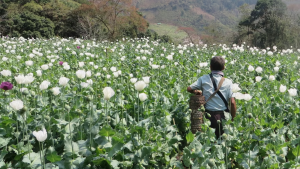
Evidence of Increased Opium Production in Myanmar
United Nations Reports: The United Nations Office on Drugs and Crime (UNODC) has reported increases in opium cultivation areas in Myanmar, suggesting a resurgence of the opium economy. These reports highlight that as eradication efforts and international attention have focused on Afghanistan, Myanmar’s opium production has quietly ramped up.
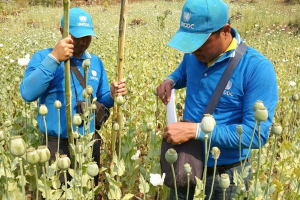
Local Observations: NGOs and local media in Myanmar have documented the expansion of opium cultivation, particularly in conflict-prone areas where government control is weak. Interviews with local farmers and observations from civil society organizations confirm this trend, indicating a growing reliance on opium as a source of income amid political instability.
Market Dynamics: There has been a reported increase in opium and heroin availability in Southeast Asia and other regions, suggesting a boost in production. Prices and purity levels of heroin in these markets can often provide indirect evidence of shifts in production centers, with Myanmar’s increasing role being a contributing factor.
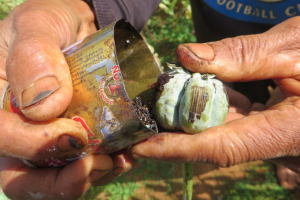
Factors Enabling Myanmar to Become the New Opium Hub
Political Instability and Conflict: Myanmar’s ongoing political turmoil, especially following the military coup in 2021, has created conditions conducive to opium cultivation. Armed conflict between the military and various ethnic armed groups disrupts normal economic activities and governance, making the opium trade a lucrative alternative.
Geographical Suitability: Myanmar’s geography, with remote and inaccessible regions, particularly in the Shan and Kachin states, provides an ideal environment for opium cultivation. These areas have suitable climates and terrains for poppy growing and have long been used for opium production.
Economic Necessity: The economic hardships faced by many communities in Myanmar, exacerbated by political instability and COVID-19 impacts, have driven farmers toward opium cultivation as a reliable source of income. The lack of viable alternative livelihoods makes opium poppy cultivation an attractive option.
Weak Law Enforcement and Governance: The chaos and challenges facing Myanmar’s governance, especially in remote areas, allow the opium trade to flourish. Law enforcement efforts are often focused on immediate security concerns, leaving narcotics control as a lower priority.
Involvement of Ethnic Armed Groups: Many of Myanmar’s ethnic armed groups are involved in the opium trade as a means of financing their operations. These groups control large swathes of territory, particularly in opium-producing areas, and have the logistical capabilities to facilitate production and trafficking.
The shift in opium cultivation to Myanmar reflects the complex interplay of political, economic, and social factors within the country and the broader region. As Myanmar’s opium production increases, the international community faces renewed challenges in addressing the implications for regional security, public health, and the global drug trade.
The Role of Ethnic Armed Groups and Regional Instability
In Myanmar, ethnic armed groups play a pivotal role in the cultivation, production, and trafficking of opium, contributing to the country’s emergence as a major opium hub. These groups, operating in the border regions of Myanmar, have historically used the opium trade as a significant source of revenue to fund their operations and sustain their autonomy from the central government. The involvement of these groups in the drug trade is intricately linked to the broader context of regional instability and ongoing conflicts.
Economic Implications for Myanmar and Neighboring Countries
The resurgence of opium production in Myanmar has significant economic implications, both domestically and for neighboring countries:
Alternative Economy: In regions controlled by ethnic armed groups, the opium economy often serves as an alternative economic system, supporting local communities but also perpetuating dependence on illicit activities.
Impact on Agriculture: The shift toward opium cultivation can displace traditional agriculture, affecting food security and economic diversity in rural areas.
Cross-Border Trade: Increased opium production boosts illicit cross-border trade, impacting neighboring countries’ economies and complicating relations due to the shared challenge of controlling drug trafficking.
Security Concerns
The expansion of opium production in Myanmar raises several security concerns:
Financing Conflict: Revenue from opium trade provides financial resources to ethnic armed groups, potentially prolonging conflicts and undermining peace efforts in the region.
Increased Crime: The lucrative nature of the opium trade attracts criminal networks involved in trafficking, leading to a rise in organized crime and corruption.
Border Security: Neighboring countries face increased challenges in border security, as efforts to curb opium trafficking require significant resources and coordination.
Health and Social Consequences
The health and social consequences of rising opium availability are profound:
Drug Addiction: Increased availability of opium and heroin can lead to higher rates of drug addiction within Myanmar and in neighboring countries, straining public health systems.
HIV/AIDS and Other Diseases: Intravenous drug use associated with heroin addiction can contribute to the spread of HIV/AIDS and other blood-borne diseases, posing significant public health challenges.
Social Disintegration: Drug addiction can lead to social disintegration, affecting families and communities. The economic and psychological pressures associated with addiction can exacerbate poverty and social instability.
The role of ethnic armed groups in Myanmar’s opium production, coupled with the region’s instability, has complex and far-reaching implications. Economically, the opium trade both supports and undermines local communities, creating a paradoxical situation where illicit activities provide critical income in the absence of viable alternatives. Security-wise, the trade fuels ongoing conflicts and criminal activities, presenting significant challenges to both national and regional stability. Health and social consequences further compound the issue, highlighting the need for comprehensive strategies that address the root causes of opium production and the multifaceted impacts it entails. Addressing these challenges requires coordinated efforts among governments, international organizations, and local communities to create sustainable economic opportunities, strengthen governance, and improve public health initiatives.
Myanmar’s Ascent in Global Opium Production: Challenges and Transitions
As Afghanistan’s dominance in opium production waned following the Taliban’s 2022 ban, Myanmar has ascended to become the primary global supplier. This shift has profound implications, not only for the local economy but also for social issues within Myanmar and the broader international community.
In Myanmar, particularly in the northeast’s Shan State, opium cultivation offers a lucrative, albeit precarious, income for impoverished farmers. The lack of viable economic alternatives, coupled with socio-economic hardships, drives farmers towards opium cultivation, despite its associated perils such as addiction and societal stigma.
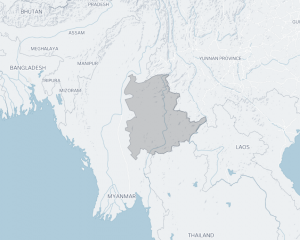
The involvement of various armed factions in the opium trade complicates efforts to combat this issue. These groups facilitate production by providing necessary resources to farmers, embedding the drug trade deeply within the local economy and social fabric.
International efforts, notably by the United Nations Office on Drugs and Crime (UNODC), have aimed to pivot farmers towards sustainable alternatives like coffee cultivation. Initiatives such as the Green Gold Cooperative (GGC) have seen success, illustrating the potential for economic transformation in opium-growing regions.
However, the post-coup instability in Myanmar has exacerbated the drug trade, underscoring the need for a comprehensive international approach to address the root causes of opium cultivation. This approach should include support for development programs, conflict resolution, and regional cooperation to mitigate the impacts of drug production and trafficking.
Myanmar’s role as a global opium supplier presents significant challenges but also opportunities for sustainable development and peacebuilding. International support and a multifaceted strategy are crucial to address the complex dynamics of opium production and its implications for Myanmar and the global community.
International Response
The shift in opium production from Afghanistan to Myanmar has elicited a varied response from the international community, reflecting the complexity of addressing the global opium trade. This response encompasses diplomatic efforts, law enforcement cooperation, and development initiatives aimed at reducing opium cultivation and its associated harms.
Global Community’s Reaction
The international community has expressed concern over the resurgence of opium production in Myanmar, recognizing the implications for global drug markets and regional stability. This concern is particularly acute given Myanmar’s history as a major opium producer and the potential for increased production to fuel ongoing conflicts and public health crises.
Diplomatic Pressure: Countries and international bodies have applied diplomatic pressure on Myanmar’s military government to address the issue, although the effectiveness of these efforts is limited by the complex political situation within the country.
Funding for Alternative Development: International donors have funded alternative development programs aimed at providing opium farmers with viable economic alternatives. These programs focus on introducing sustainable agricultural practices and improving access to markets for legal crops.
Support for Drug Treatment Programs: Recognizing the health impacts of increased opium production, some international efforts have focused on supporting drug treatment and harm reduction programs within Myanmar and in neighboring countries affected by opium trafficking.
Efforts to Combat Opium Cultivation and Trade in Myanmar
Efforts to combat opium cultivation and trade in Myanmar have involved a combination of enforcement and development strategies:
Eradication Campaigns: The Myanmar government and, in some cases, ethnic armed groups have conducted opium eradication campaigns. However, these efforts often face resistance from local communities for whom opium is a critical source of income.
Law Enforcement Cooperation: Regional cooperation among law enforcement agencies in Southeast Asia, facilitated by bodies such as the Association of Southeast Asian Nations (ASEAN), has been crucial in intercepting opium and heroin trafficked out of Myanmar.
Integrated Rural Development: Projects aimed at integrated rural development seek to address the root causes of opium cultivation by improving infrastructure, healthcare, and education, alongside introducing alternative livelihoods.
The Role of International Organizations and Cooperation among Nations
International organizations play a critical role in coordinating the response to opium production in Myanmar, facilitating cooperation among nations and providing technical expertise and funding.
United Nations Office on Drugs and Crime (UNODC): The UNODC plays a leading role in monitoring opium production and trafficking routes, providing data and analysis to guide policy decisions. It also supports member states in implementing drug control and alternative development programs.
Regional Initiatives: Regional initiatives, such as those under the umbrella of ASEAN, focus on enhancing border security, sharing intelligence, and conducting joint operations against drug trafficking networks.
Bilateral and Multilateral Aid: Countries affected by heroin trafficking originating in Myanmar, including those in Europe, North America, and Asia, provide bilateral aid to support alternative development and law enforcement efforts. Multilateral aid, channeled through international organizations, also supports health and development initiatives aimed at mitigating the impacts of opium production.
The international response to the shift in opium production to Myanmar underscores the challenges of addressing a problem that spans borders and affects countries differently. While efforts to combat opium cultivation and trade in Myanmar are ongoing, success requires sustained cooperation among nations, international organizations, and local stakeholders. Addressing the underlying economic, social, and political factors contributing to opium production remains crucial for any long-term solution.
Conclusion
The shift in opium production from Afghanistan to Myanmar marks a significant development in the global landscape of narcotics trade, with deep implications for international drug policy and regional stability. This transition underscores the adaptability of illicit drug markets to geopolitical changes and highlights the challenges facing nations in combating opium cultivation and its consequences.
Afghanistan’s long-standing position as the world’s leading opium producer has been challenged by the Taliban’s opium production ban, leading to a notable shift towards Myanmar, a country with a history of opium cultivation influenced by internal conflict and economic necessity.
In both Afghanistan and Myanmar, a complex mix of economic hardship, lack of viable livelihood alternatives, political instability, and the involvement of armed groups has fueled opium production.
Afghanistan’s opium production has had significant global repercussions, from feeding the international heroin market to financing conflict. The shift to Myanmar is likely to redistribute these impacts, affecting drug trafficking routes, public health, and regional security dynamics.
Efforts to address the shift in opium production have included diplomatic pressure, support for alternative development, and enhanced law enforcement cooperation, spearheaded by international organizations and affected nations.
The relocation of opium production to Myanmar poses new challenges for international drug policy, necessitating a reassessment of strategies to combat the global narcotics trade. It emphasizes the need for comprehensive approaches that address the root causes of opium cultivation, such as poverty, conflict, and lack of governance. Additionally, this shift highlights the importance of regional stability, as the drug trade can exacerbate existing conflicts and undermine efforts towards peace and development.
Addressing the challenges posed by opium cultivation requires a coordinated international response that transcends mere eradication efforts. This response should integrate:
- Sustainable Development: Implementing alternative livelihood programs that offer viable economic opportunities to communities dependent on opium cultivation.
- Enhanced Regional Cooperation: Strengthening collaboration among affected countries to improve border security, share intelligence, and disrupt trafficking networks.
- Comprehensive Policy Approaches: Adopting policies that balance enforcement with prevention, treatment, and rehabilitation, acknowledging the public health aspect of drug addiction.
- Support for Governance and Peacebuilding: Providing support for governance and peacebuilding efforts in regions affected by opium cultivation to address the underlying causes of conflict and instability.
The shift in opium production to Myanmar serves as a critical reminder of the dynamic nature of the global drug trade and the need for resilient, adaptive strategies. By fostering international cooperation and addressing the socio-economic and political dimensions of opium cultivation, the global community can move towards a more effective response to the challenges posed by the narcotics trade.
[1] PhD Researcher, Bangladesh University of Professionals.